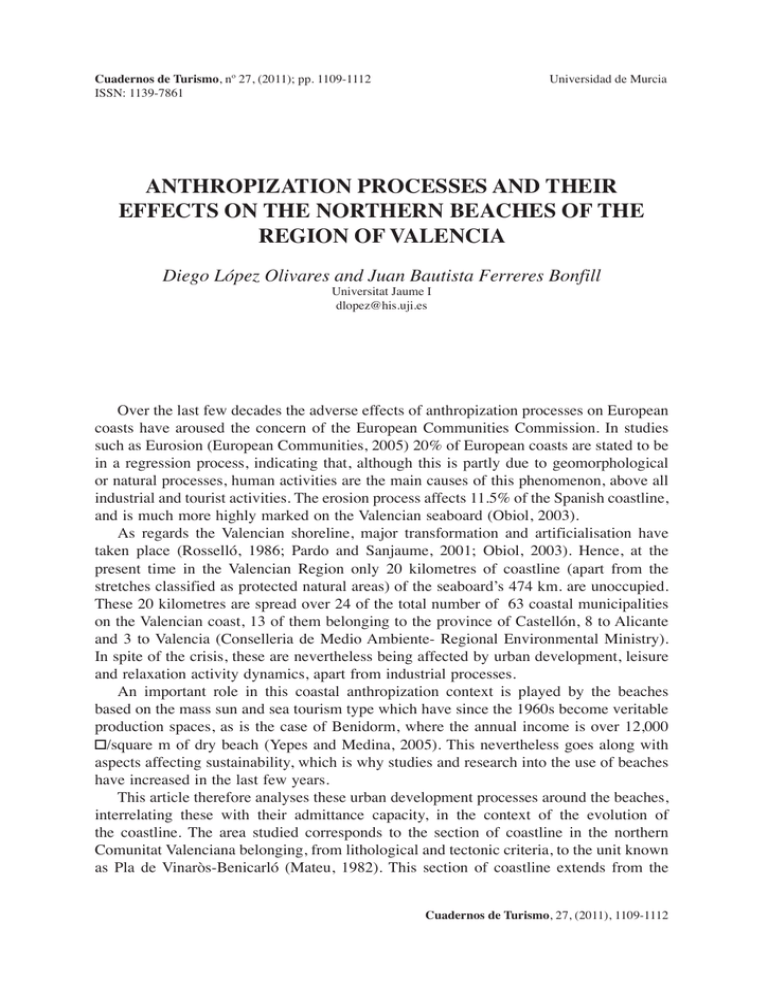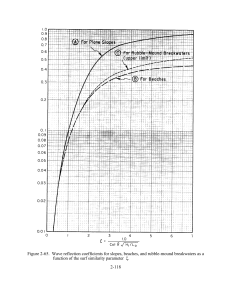anthropization processes and their effects on the northern beaches
Anuncio

Cuadernos de Turismo, nº 27, (2011); pp. 1109-1112 ISSN: 1139-7861 Universidad de Murcia ANTHROPIZATION PROCESSES AND THEIR EFFECTS ON THE NORTHERN BEACHES OF THE REGION OF VALENCIA Diego López Olivares and Juan Bautista Ferreres Bonfill Universitat Jaume I dlopez@his.uji.es Over the last few decades the adverse effects of anthropization processes on European coasts have aroused the concern of the European Communities Commission. In studies such as Eurosion (European Communities, 2005) 20% of European coasts are stated to be in a regression process, indicating that, although this is partly due to geomorphological or natural processes, human activities are the main causes of this phenomenon, above all industrial and tourist activities. The erosion process affects 11.5% of the Spanish coastline, and is much more highly marked on the Valencian seaboard (Obiol, 2003). As regards the Valencian shoreline, major transformation and artificialisation have taken place (Rosselló, 1986; Pardo and Sanjaume, 2001; Obiol, 2003). Hence, at the present time in the Valencian Region only 20 kilometres of coastline (apart from the stretches classified as protected natural areas) of the seaboard’s 474 km. are unoccupied. These 20 kilometres are spread over 24 of the total number of 63 coastal municipalities on the Valencian coast, 13 of them belonging to the province of Castellón, 8 to Alicante and 3 to Valencia (Conselleria de Medio Ambiente- Regional Environmental Ministry). In spite of the crisis, these are nevertheless being affected by urban development, leisure and relaxation activity dynamics, apart from industrial processes. An important role in this coastal anthropization context is played by the beaches based on the mass sun and sea tourism type which have since the 1960s become veritable production spaces, as is the case of Benidorm, where the annual income is over 12,000 €/square m of dry beach (Yepes and Medina, 2005). This nevertheless goes along with aspects affecting sustainability, which is why studies and research into the use of beaches have increased in the last few years. This article therefore analyses these urban development processes around the beaches, interrelating these with their admittance capacity, in the context of the evolution of the coastline. The area studied corresponds to the section of coastline in the northern Comunitat Valenciana belonging, from lithological and tectonic criteria, to the unit known as Pla de Vinaròs-Benicarló (Mateu, 1982). This section of coastline extends from the Cuadernos de Turismo, 27, (2011), 1109-1112 1110 DIEGO LÓPEZ OLIVARES AND JUAN BAUTISTA FERRERES BONFILL mouth of the river Sénia to the Peñíscola tombola, with a length of 22 km., 13 km. of which belong to the beaches. The main aim consists in determining the admittance capacity of the beaches in El Pla de Vinaròs-Benicarló in the northern Valencian Region according to their size (in which the evolution of the coastline has an effect) and their relationship with the accommodation capacity of their hotels and residential or residential tourism settings. These are some of the specific objectives: • Finding out the evolution of the coastline, basically of the beaches. • Analysing the size of the beaches, above all of the fine sand surface areas. • Determining the types of the beaches and their admittance capacity based on the urban development generated. As regards the procedure, the method of superimposing aerial photography was used for the evolution of the coastline, contrasting different flights in the area (years 1947, 1957, 1981, 2002, 2003, 2005 and 2007) of the Ministry of the Environment, and of the Ports and Coasts Service of the Generalitat Valenciana (regional government) Infrastructure and Transport Ministry, which have also provided orthophotographs of the area studied. All of this work has been completed with the analysis of projects on the subject of the municipalities of Vinaròs, Banicarló and Peñíscola, and with on-site field work, to establish the size of the beaches and their characteristics. There has in parallel been an analysis of the urban development in the surroundings of the beaches from the data provided by the building permit files granted for new building work, which has enabled both the number and the type and location of the housing to be found out. Hence, the main results reveal that the coastlines of the Comunitat Valenciana form part of the coastal regression processes of European spaces due to natural processes, but also due to the ones generated by the major anthropization which has been produced by industrial activity and tourism. As regards tourism, its effects have been felt on Valencian beaches, where 58% are subject to regression. 24 of the 35 beaches and coves analysed on the northern seaboard of the Comunitat Valenciana 24 are thus seen to be regressive and only 6 are seen to be progressive, the rest being in a situation of certain stability. The Valencian tourist model has had an influence on this, through being largely based on residential and tourist-residential development around the beaches, whose over 2.6 million accommodation places have meant that their main beaches, in the case of the northern Community, are urban or semi-urban in nature. Apart from this the real production character of these beaches requires a detailed follow-up of their dimensions, above all of the surface of dry sand available, which at the present time is 368,296 square m in the study area, 50.1% of which correspond to Peñíscola, 26.4% to Vinaròs and 23.5% to Benicarló. Relating these dry sand surface areas with the accommodation supply, potential users, the average admittance capacity for the area is 2.36 square m per user, far under the optimum level established of 7.5 square m per user, due to the prevalence of dry sand surfaces on the urban type beaches. This index nevertheless drops even lower if we consider that users are mainly located on a strip of dry sand beside the sea, which ranges from 15 to 20 metres in width. One should nevertheless stress that on Cuadernos de Turismo, 27, (2011), 1109-1112 ANTHROPIZATION PROCESSES AND THEIR EFFECTS ON THE NORTHERN BEACHES … 1111 some beaches such as Northern Peñíscola or Clot de Vinaròs the urban pressure of their settings means that the strip of dry sand is much more extensive, the reason for applying the potential capacity. In short, given the great appeal and productive nature of these beaches, the main objective of the demand in the summertime, there needs to be continuing monitoring of this predominance of regression on the coastline, especially on the beaches. In parallel the intensity of urban development processes must be appraised in some of its sections, as these are too far over the commonly accepted admittance capacity ratios, which goes against the perception of well-being for people on the beaches and their competitiveness. REFERENCES BARRAGÁN, J.M. (1997): Medio ambiente y desarrollo en las áreas litorales. Guía práctica para la planificación y gestión integradas. Oikos-Tau. Barcelona. BARRAGÁN, J.M. (2004): Las áreas litorales de España. Del análisis geográfico a la gestión integrada. Ariel. Barcelona. CITTB. Centre d’Investigació i Tecnologies Turístiques de les Illes Balears (2003): La mesura de la sostenibilitat del turisme a les Illes Balears. Universitat de les Illes Balears. COMISIÓN DE LAS COMUNIDADES EUROPEAS (2006): Libro Verde. Hacia una futura política marítima de la Unión. Perspectiva europea de los océanos y los mares. Bruselas. 7.6.2006. CONSELLERIA DE TURISME (2010): Oferta turística municipal y comarcal de la Comunitat Valenciana 2009. Generalitat Valenciana. Conselleria de Turisme. Valencia. EUROPEAN COMMUNITIES (2005): Vivir con la erosión costera en Europa. Oficina de Publicaciones Oficiales de las Comunidades Europeas. Luxemburgo. GARCÍA, C.; SERVERA, J. (2003): «Impacts of tourism development on water demand an beach degradation on the island of Mallorca (Spain)». Geografiska Annaler, 85, A, pp. 287-300. HOUSTON, J.R. (1995): «The Economic value of Beaches». CERcular, CERC-95, 4, pp. 1-4. HOUSTON, J.R. (1996): «International and U.S. Beaches». Shore & Beaches, 64(2), pp. 3-4. IRIBAS, J.M. (2002): «Una perspectiva sociológica sobre las playas». O.P. Ingeniería y Territorio, 61 (3), pp. 78-85. LEATHERMAN, S.P. (1997): «Beach rating: a methodological approach». Journal of Coastal Research, 13 (1), pp. 253-258. LÓPEZ OLIVARES, D. (2003): «La evaluación de los recursos territoriales turísticos de carácter básico: El caso de las playas del norte de la Comunidad Valenciana». Investigaciones Geográficas, 32, pp. 111-135. LÓPEZ OLIVARES, D. et al. (2005): «Cambios y transformaciones en el actual modelo turístico de España». Annals of Tourism Research en Español, 7(2), pp. 423-446. Cuadernos de Turismo, 27, (2011), 1109-1112 1112 DIEGO LÓPEZ OLIVARES AND JUAN BAUTISTA FERRERES BONFILL LÓPEZ OLIVARES, D. (Ed.) (2007): Turismo en los espacios litorales. Sol, Playa y Turismo Residencial. Tirant lo Blanch. Valencia. MATEU BELLES, J.F. (1982): El norte del País Valenciano. Geomorfología litoral y prelitoral. Universidad de Valencia. Sección de Geografía. Valencia. MAS, LL. y BLÁZQUEZ, M. (2005): «Anàlisi de freqüentació d’ús a les platges i estudi de paràmetres de sostenibilitat associats». Documents d’Anàlisi Geogràfica, 45, pp. 15-40. MEDINA, J.R. TINTORÉ y DUARTE, C.M. (2001): «Las praderas de Posidonia oceánica y la regeneración de playas». Revista Obras Públicas, 3409, pp. 31-43. MINISTERIO DE OBRAS PÚBLICAS Y URBANISMO. Dirección General de Puertos y Costas (1984): Playas. Modelos, tipos y sugerencias para su ordenación. Madrid. MOPU. MORGAN, R. (1999): «A novel, user-base rating system for tourist beaches». Tourism Management, 20, pp. 393-410. OBIOL, M. (2003): «La regeneración de playas como factor clave del avance del turismo valenciano». Cuadernos de Geografía, 73-74, pp. 121-146. PARDO, J. y SANJAUME, E. (2001): «Análisis multiescalar de la evolución costera». Cuadernos de Geografía, 69-70, pp. 95-125. PASKOFF, V. (1999): Les littoraux. Impact des aménagements sur leur évolution. Masson. Paris. PEREIRA da SILVA, C. (2004): «Landscape perception and coastal management: A methodology to encourage public participation». Journal of Coastal Research, Special Issue, 39. ROIG, F.X. (2003): «Análisis de la relación entre capacidad de carga física y capacidad de carga perceptual en las playas naturales de Menorca». Investigaciones Geográficas, 31, pp. 107-118. ROSSELLÓ VERGER, V.M. (1986): «L’artificialització del litoral valencià». Cuadernos de Geografía, 38, pp. 1-28. RUBIO LÓPEZ, D. (2003): Gestión integral de playas. Síntesis. Madrid. VERA, J.F. e IVARS, J.A. (2002): «Turismo, territorio y desarrollo regional en la Comunidad Valenciana». En BLANQUER, D. (Coord.): Ordenación y gestión del territorio turístico. Tirant lo Blanch. Valencia, pp. 151-189. VERA, J.F. (2007): «Turisme i Territori. Realitats i reptes per a una nova etapa des de la sostenibilitat com a referència». En Llibre Verd del Territori Valencià. Valencia, pp. 169-183. WILLIAMS, A.T.; MORGAN, R. (1995): «Beach awards and rating systems». Shore and Beach, 63 (4), pp. 29-33. YEPES, V. (1999): «Las playas en la gestión sostenible del litoral». Cuadernos de Turismo, 4, pp. 89-110. YEPES, V y MEDINA, J.R. (2005): «Land Use Tourism Models in Spanish Coastal Areas. A Case Study of the Valencia Region». Journal of Coastal Research, Special Issue, 49, pp. 83-88. Cuadernos de Turismo, 27, (2011), 1109-1112


